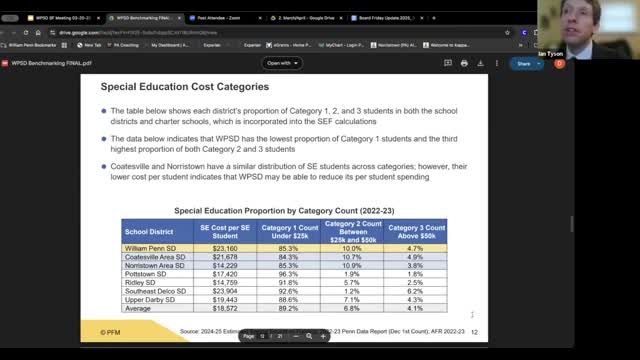
This article was created by AI using a video recording of the meeting. It summarizes the key points discussed, but for full details and context, please refer to the video of the full meeting. Link to Full Meeting
One of the primary topics was the district's expenditure on special education services. William Penn is currently facing a higher cost burden compared to its peers, with a greater share of students requiring costly services. Despite similar demographics with districts like Coatesville and Norristown, William Penn's spending per student is notably higher, while federal reimbursements for these services remain below average. This discrepancy places additional pressure on the district's budget, necessitating a closer examination of how special education services are structured and funded.
The committee also addressed the rising costs associated with charter school tuition. William Penn has a higher percentage of students enrolled in charter schools compared to the average of its peer group. This trend raises concerns about the financial sustainability of the district, as charter school tuition can significantly impact the overall budget. The committee suggested that the district explore competitive strategies to retain students, particularly in the realm of cyber charter schools, where the cost of providing education may be lower than the tuition fees currently being paid.
Operational efficiency was another focal point of the meeting. The district's spending on operations and maintenance was found to be among the lowest per building compared to its peers, indicating effective management in this area. However, transportation costs emerged as a potential area for improvement. While the district has a high fill rate for vans used in transporting students, the costs associated with larger buses were identified as exceeding the average. The committee recommended a review of transportation strategies to identify possible efficiencies, particularly concerning the utilization of 72-passenger buses.
In summary, the Budget & Finance Committee's discussions underscored the financial challenges facing the William Penn School District, particularly in special education and charter school tuition. The meeting emphasized the need for strategic planning and resource management to address these issues effectively. As the district moves forward, it will be crucial to implement recommendations aimed at enhancing operational efficiencies and exploring competitive educational offerings to ensure fiscal sustainability.
Converted from Budget & Finance Committee Meeting - March 20, 2025 meeting on March 28, 2025
Link to Full Meeting
Comments
View full meeting
This article is based on a recent meeting—watch the full video and explore the complete transcript for deeper insights into the discussion.
View full meeting